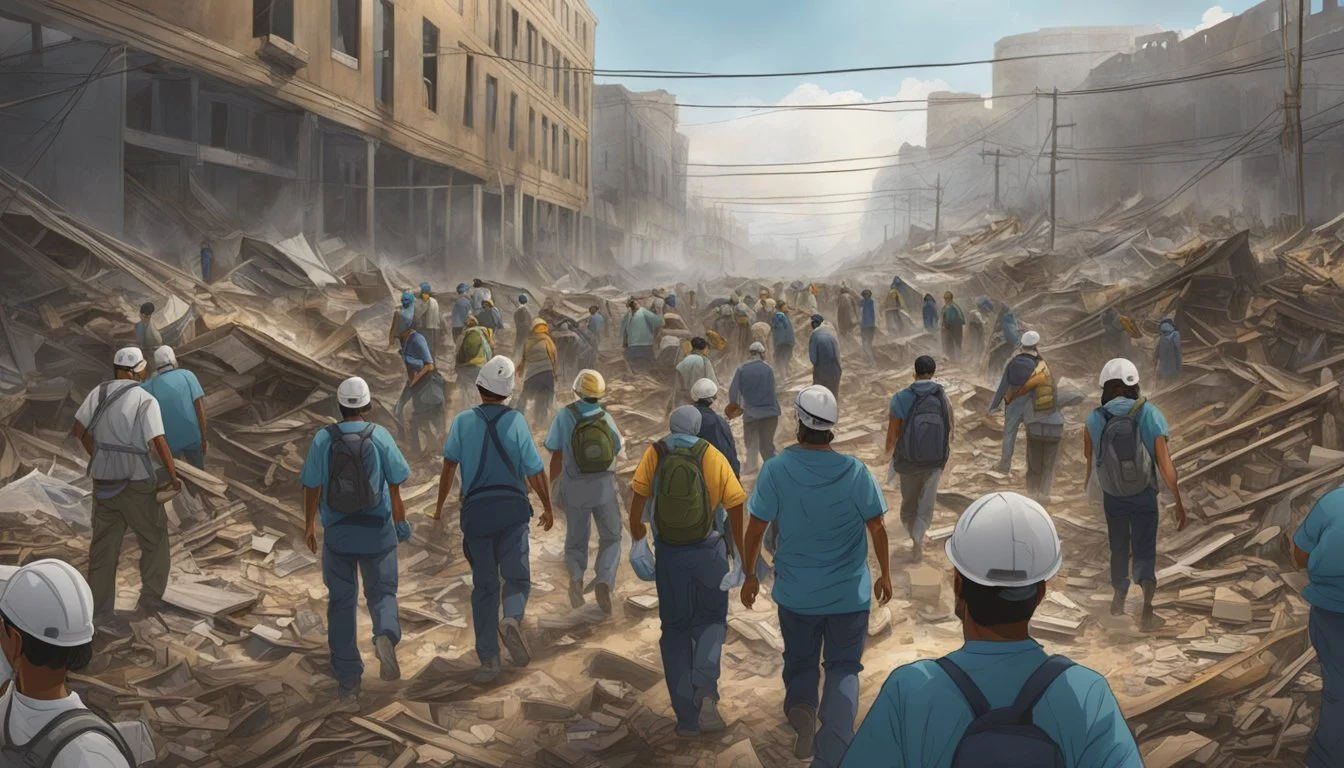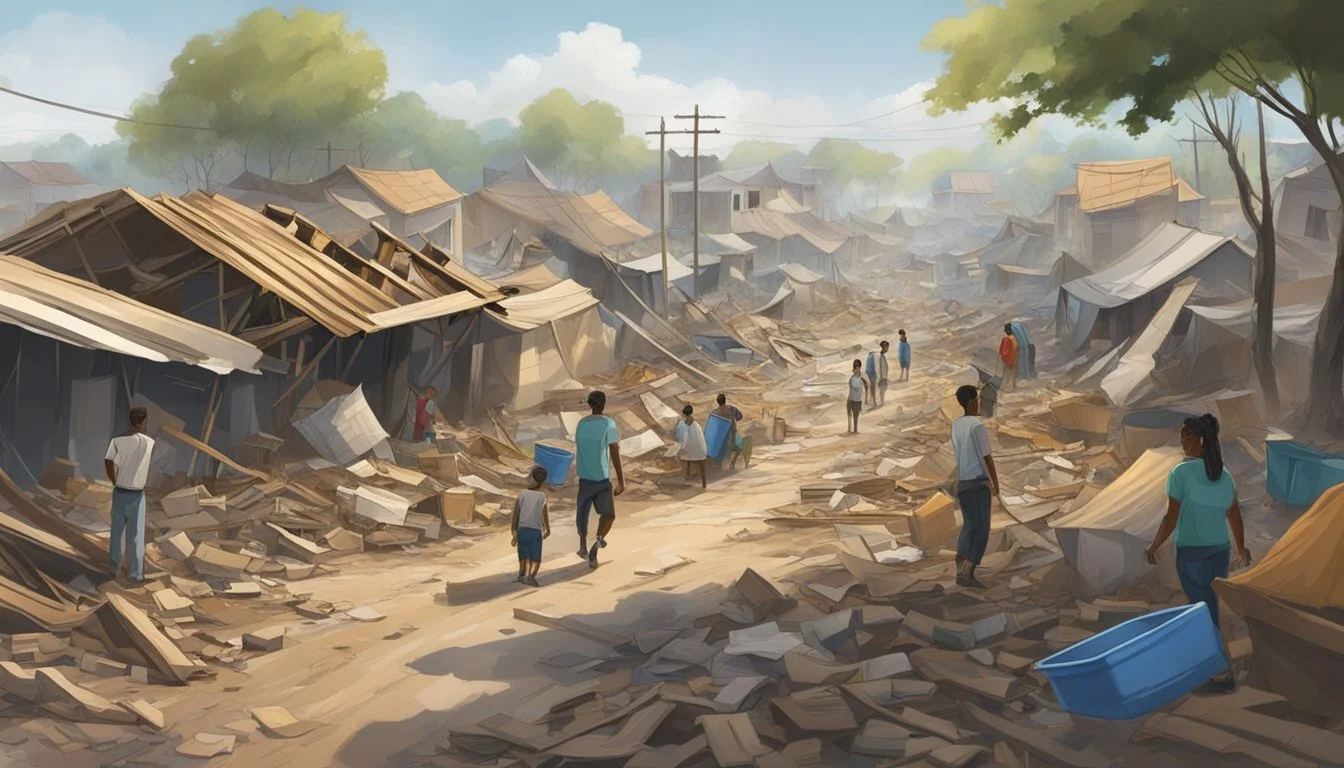9 Common Challenges Faced by Survivors of Natural Disasters
Navigating Recovery and Resilience
Survivors of natural disasters face a myriad of challenges that go beyond the immediate aftermath of the event. These obstacles can affect their physical, emotional, and psychological well-being, making recovery a complex and prolonged process. Understanding these challenges is crucial for providing effective support and aid to those affected.
Efforts to identify and address these barriers are ongoing, highlighting the need for comprehensive strategies in disaster recovery and aid distribution. Recognizing the common issues survivors encounter can better equip communities, organizations, and governments to deliver the necessary assistance and resources.
1) Psychological Trauma
Natural disasters often result in significant psychological trauma for survivors. This trauma can manifest as post-traumatic stress disorder (PTSD), anxiety, depression, and other emotional disorders. The stress of experiencing events such as earthquakes, tornadoes, and hurricanes can deeply affect mental health.
In addition to PTSD, survivors may experience traumatic grief. This particular form of grief arises from the sudden and violent loss of loved ones, as well as the destruction of homes and communities. It can complicate the grieving process, making it more severe and prolonged.
Behavioral problems may also emerge in the aftermath of a disaster. Survivors might turn to addictive behaviors, such as substance abuse, as a means of coping with their distress. Emotional regulation becomes a challenge, leading to potentially harmful coping strategies.
Some survivors demonstrate a notable degree of psychological resilience. Factors such as community support and adaptive reactions help protect against long-term mental health issues. Resilient individuals are able to maintain a stable mental state despite the traumatic events they have endured.
Understanding and addressing the psychological trauma resulting from natural disasters is crucial. Professional mental health support and community interventions play a vital role in helping survivors rebuild not just their physical lives but their emotional well-being as well.
2) Loss of Property
Natural disasters often result in significant property loss. Homes, businesses, and personal possessions can be obliterated by events like hurricanes, earthquakes, and floods. The destruction of physical belongings is immediate and visible.
Aside from the emotional toll, losing property leads to substantial financial strain. Repairing or replacing structures and items may require extensive time and resources. Insurance may not always cover the full extent of losses, adding to the financial burden.
The loss of property also impacts daily routines and stability. Displaced individuals must find temporary housing, sometimes in unfamiliar environments. This disruption can lead to stress and anxiety as they adapt to new living conditions.
Long-term rebuilding efforts can stretch for months or even years. Communities must band together to restore what was lost, which can be a lengthy and challenging process.
For more detailed insights on the impact of losing property during natural disasters, this article discusses various types of losses faced by victims.
3) Displacement
Displacement is one of the most profound impacts of natural disasters. Environmental displacement and disaster-induced displacement often occur due to sudden events like floods, hurricanes, and earthquakes. These incidents force individuals and families to leave their homes abruptly.
The number of people affected by displacement is staggering. In 2010 alone, more than 40 million people were displaced by sudden-onset disasters such as floods and earthquakes. Displacement is particularly challenging for vulnerable populations who may lack access to essential services.
Those displaced often face isolation from their usual support systems. This can include separation from family, friends, and healthcare providers, which can exacerbate the stress and trauma experienced during and after the disaster.
Limited mobility can also hinder access to disaster assistance. People with disabilities or the elderly may find it especially difficult to navigate evacuation procedures and reach safe locations.
National and local disaster risk reduction laws aim to address and reduce risks associated with disaster displacement. Effective strategies and plans are essential for strengthening the resilience of affected individuals and communities.
International efforts, such as the policies advocated by the United Nations and the Internal Displacement Monitoring Centre, seek to provide comprehensive support and protection to displaced individuals. These efforts are crucial in mitigating the long-term impacts of displacement.
4) Healthcare Access Challenges
Natural disasters often strain healthcare systems by increasing the volume of patients needing urgent care. Facilities may become damaged or inaccessible, limiting the ability to provide necessary services. This is particularly concerning for those requiring chronic or specialized care.
Vulnerable populations, including the elderly and individuals with preexisting health conditions, face heightened risks. Disparities in healthcare access can worsen due to disrupted transportation and communication systems.
In many cases, healthcare workers must operate under non-optimal conditions. For example, providing cancer care in disaster-affected areas presents unique challenges, as regular treatments may be interrupted.
Digital health technologies offer promising solutions. These tools can support remote consultations and continuous care, especially in remote or underserved areas. Developing climate-resilient healthcare systems is crucial for ensuring the continuity of care during and after disasters.
Responders need innovative strategies to address these challenges effectively. Access to reliable healthcare in disaster situations can be critical for reducing mortality and ensuring the well-being of affected populations. Mitigating health disparities in such scenarios is essential for promoting health equity.
5) Economic Loss
Natural disasters can lead to significant economic losses. These losses often stem from destruction of infrastructure, homes, and businesses. Economic activities may be disrupted, impacting both local and national economies.
In poorer countries, the effects can be more severe due to limited resources for recovery. Economic recovery after natural disasters can be prolonged, as rebuilding efforts require substantial financial investment.
Direct economic damage from extreme weather events has grown faster than GDP for decades. Projections indicate this trend will continue, highlighting the need for effective economic policies to mitigate impact as discussed by NBER.
Modeling studies show that increased population and economic growth in disaster-prone areas have contributed to rising economic losses. Future losses are expected to increase due to continued economic exposure and climate change, underscoring the importance of mitigation policies.
Between 1998 and 2017, climate-related and geophysical disasters killed 1.3 million people and impacted 4.4 billion. These events led to significant economic losses, emphasizing the stark reality of disaster-related economic impacts.
6) Disruption of Education
Natural disasters often cause significant disruption to education systems. Schools may be destroyed or severely damaged, making it impossible for students to attend classes. This interruption can lead to long-term academic setbacks for children.
Teachers and students are frequently displaced, adding another layer of complexity to resuming educational activities. In such situations, the loss of educational materials makes it challenging to maintain a consistent learning environment.
In the wake of natural disasters, schools sometimes serve as emergency shelters, further delaying the resumption of normal academic operations. This dual role of educational facilities hampers the ability to provide uninterrupted learning.
Restoring educational services quickly is critical. Not only does this address the immediate need for education, but it also helps in stabilizing the lives of affected children. Educational continuity is essential for long-term recovery and emotional stability.
Governments and organizations like USAID play a crucial role in supporting education during crises. They help develop certification policies for emergency teachers and establish Memorandums of Understanding with relevant actors to streamline educational recovery efforts. These measures are vital for ensuring that education systems can withstand and recover from the impacts of natural disasters.
7) Access to Clean Water
Natural disasters often disrupt access to clean water, causing significant health risks. Events like floods, hurricanes, and earthquakes can break pipes and contaminate water supplies. This leaves survivors vulnerable to diseases from polluted water sources.
Water-related disasters account for a large portion of natural calamities. The global climate crisis exacerbates these events, increasing their frequency and intensity. This makes clean water access more critical yet more challenging.
Even after the immediate disaster passes, maintaining water quality remains difficult. Infrastructure may be damaged, limiting regular water treatment processes. Power outages further complicate this issue, hindering the operation of essential water treatment facilities.
People exposed to contaminated water sources face various health risks. Infections and diseases spread easily in these conditions, particularly in areas with poor sanitation. Access to clean water becomes vital to prevent outbreaks and protect public health.
Efforts to prepare drinking water utilities for such disasters are ongoing. Programs are in place to help water and wastewater utilities manage risks. These initiatives aim to bolster infrastructure resilience and ensure safe water availability during crises.
Many children live in areas of high water vulnerability. They are especially at risk, as both water scarcity and quality issues affect their health. Ensuring access to clean water can significantly improve the wellbeing of these vulnerable populations.
8) Social Isolation
Survivors of natural disasters often face significant social isolation. Displacement from their homes and communities disrupts social networks. This separation can contribute to feelings of loneliness.
Social support systems are crucial during recovery. Lack of access to familiar social structures can lead to heightened stress and anxiety. Individuals may struggle with the loss of daily social interactions.
Community dynamics change following disasters. New environments and the loss of familiar surroundings can make it challenging to establish new connections. Survivors may find it difficult to seek help or share their experiences.
Social isolation exacerbates mental health issues. The absence of a support network can hinder emotional recovery. Access to mental health services becomes even more critical in these situations.
Rebuilding social networks is essential. Community programs and support groups can provide a space for reconnection. Promoting social ties helps alleviate the isolation experienced by disaster survivors.
Psychologists and social workers play a vital role. Creating opportunities for engagement and interaction can significantly help. Their intervention supports emotional and psychological healing for affected individuals.
Efforts to combat social isolation must be prioritized. Ensuring survivors have access to various forms of social support fosters resilience and improves recovery outcomes.
9) Food Insecurity
Food insecurity is a significant challenge for survivors of natural disasters. Disasters such as floods, earthquakes, and hurricanes can disrupt food production, damage crops, and destroy supply chains. This often leaves affected populations without access to sufficient, safe, and nutritious food.
A study highlighted that food security challenges following disasters in Iran are related to underlying issues, process management, and coordination difficulties. These challenges become particularly evident in the immediate aftermath when resources are scarce and the need for efficient distribution is critical.
Increased food prices exacerbate the problem. For instance, the war in Ukraine and the COVID-19 pandemic have driven global food prices to record highs, intensifying food insecurity worldwide. This makes it even harder for disaster-affected communities to recover.
Natural disasters can also lead to increased food pantry use, as observed in the wake of Hurricane Katrina. Many households find themselves financially incapable of purchasing food due to the economic disruptions caused by disasters.
Effective disaster response must include strategies to address food insecurity. This involves not only immediate relief efforts but also long-term plans to rebuild local food systems and supply chains. Providing support for local agriculture and ensuring equitable access to food are crucial steps in mitigating the impact of food insecurity on disaster survivors.
In essence, addressing food insecurity requires coordinated efforts that span various sectors, including agriculture, logistics, and social services.
Emotional and Psychological Impact
Survivors of natural disasters often face significant emotional and psychological challenges. These can manifest in various ways, such as Post-Traumatic Stress Disorder (PTSD), depression and anxiety, and profound grief and loss.
Post-Traumatic Stress Disorder (PTSD)
Following a natural disaster, many survivors experience symptoms of PTSD. They may have flashbacks, nightmares, and severe anxiety related to their experiences.
These symptoms often interfere with daily life, leading to difficulties in maintaining routines and relationships. Someone enduring these symptoms for more than a month should seek professional help.
PTSD can also result in physical symptoms like headaches and nausea, as outlined in this article. Treatment usually involves therapy, such as cognitive-behavioral therapy (CBT), and sometimes medication.
Depression and Anxiety
Survivors frequently experience depression and anxiety due to the trauma of the event and the subsequent loss of normalcy. Symptoms may include persistent sadness, difficulty sleeping, and feelings of hopelessness.
Additionally, anxiety disorders may emerge, manifesting through constant worry, irritability, and panic attacks. According to Psychology Today, these mental health conditions require proper attention and care.
Therapy, support groups, and medications are common treatments to help individuals manage these conditions effectively.
Grief and Loss
Natural disasters often result in the loss of loved ones, homes, and communities, leading to profound grief. Survivors may feel overwhelmed with sadness, anger, and guilt.
These emotions can last for a significant period and complicate the recovery process. It's important for individuals to find healthy ways to cope with their grief, such as talking to others, participating in support groups, or engaging in therapeutic activities.
Recognizing and addressing these feelings is vital for long-term recovery. Resources and further information on disaster psychology can be found in this overview.
Social and Community Challenges
Survivors of natural disasters often experience social isolation, community displacement, and stigma and discrimination. These issues can significantly impact their ability to recover and regain a sense of normalcy.
Social Isolation
After a natural disaster, social isolation is a common problem. Disasters frequently disrupt traditional social networks, leaving individuals to cope without their usual support systems. This isolation can worsen mental health issues such as depression and anxiety.
Older adults and those with fewer social ties are particularly vulnerable. Loss of communication infrastructure, such as phone lines and internet, can also hinder social interactions. Efforts to rebuild these networks are crucial, pointing to the need for community-driven initiatives and consistent outreach programs to reconnect affected individuals.
Community Displacement
Community displacement involves the forced relocation of individuals due to unsafe living conditions following a disaster. This displacement disrupts the cohesive fabric of communities as families are separated and relocated to different areas.
Relocating can lead to long-term challenges in finding stable housing, accessing education, and securing employment. Temporary living arrangements often exacerbate stress and anxiety. Policies aimed at ensuring quick and adequate housing solutions are essential, emphasizing the need for efficient disaster response plans that address both immediate and long-term housing needs.
Stigma and Discrimination
Stigma and discrimination can surface against survivors of natural disasters, especially those from marginalized communities. Displaced individuals might face prejudice and unfair treatment in new settings, affecting their integration and access to resources.
Those living in temporary shelters or receiving financial aid may be unfairly labeled or stereotyped, which can hinder their recovery process. Public awareness campaigns and inclusive policies are vital in combating this stigma. Support services must ensure equal treatment and benefits to all survivors, regardless of their background or socioeconomic status.








